by Bruce Wells | Jan 10, 2025 | Petroleum Art
Dr. Seuss created zoological oddities for Esso products of Standard Oil Company of New Jersey.
Seuss the oilman? Thirty years before the Grinch stole Christmas in 1957, many strange and wonderful critters of the popular children’s book author could be seen in Standard Oil Company advertising campaigns.
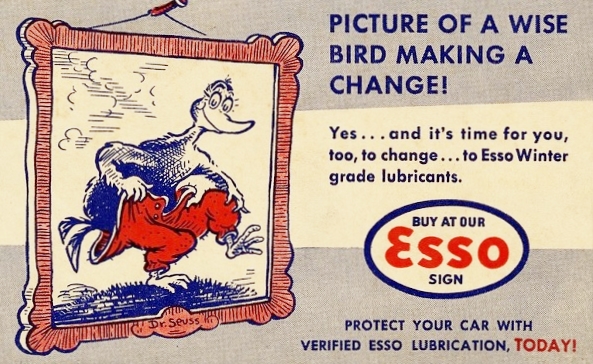
Between 1930 and 1940, Theodor Seuss Geisel created distinctive characters for Standard Oil advertising campaigns, including this “wise bird” for Essolube oil change cards. Illustration courtesy University of California San Diego Library.
During the Great Depression, fanciful creatures drawn by the future Dr. Seuss promoted Essolube and other products for Standard Oil of New Jersey. He later said his experience at Standard, “taught me conciseness and how to marry pictures with words.”

A 1927 cartoon by Theodor Seuss Geisel featured Standard Oil’s petroleum product “Flit,” a popular bug spray.
In the cartoon that launched his career, Theodor Seuss Geisel drew a peculiar dragon inside a castle. The January 14, 1928, issue of New York City’s Judge magazine featured the scaled beast. Geisel would introduce many less threatening characters inhabiting his imaginative menagerie.
Bug Spray
“Flit,” was a popular bug spray of the day — especially against flies and mosquitoes. It was one of many Standard Oil Company of New Jersey consumer products derived from oil and natural gas (also see petroleum products).
Late in 1927, Standard Oil’s growing advertising department, which had focused on sales of Standard and Esso gasoline, lubricating oil, fuel oil and asphalt, reorganized to promote other products, according to author Alfred Chandler Jr.

Dr. Seuss later said his experience working at Standard Oil helped him develop his fantastical characters and tales.
“Specialties, such as Nujol, Flit, Mistol, and other petroleum by-products that could not be effectively sold through the department’s sales organization were combined in a separate subsidiary — Stanco,” noted Chandler in his book, Strategy and Structure: Chapters in the History of the American Industrial Enterprise.
Chandler’s 1962 book also examined General Motors Company, Sears, Roebuck and Company, and gunpowder manufacturer E.I. du Pont de Nemours.
“Quick, Henry, the Flit!”
Geisel’s fortuitous bug-spray cartoon depicted a medieval knight in his bed, facing a dragon who had invaded his room, and lamenting, “Darn it all, another dragon. And just after I’d sprayed the whole castle with Flit.”

According to an anecdote in Judith and Neil Morgan’s 1995 book Dr. Seuss and Mrs. Geisel, the wife of the advertising executive who handled the Standard Oil account was impressed by the cartoon.
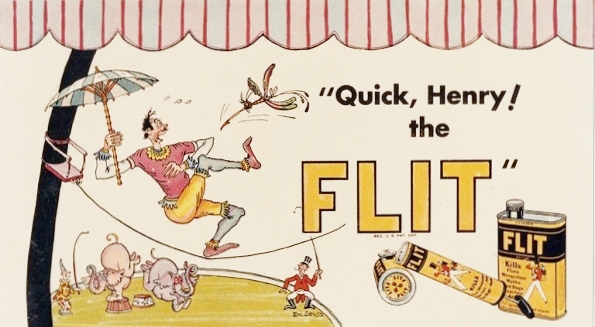
Circa 1935 ad for a Standard Oil petroleum product was characteristic of the imagination that would make Ted Geisel the definitive children’s book author. Illustration courtesy University of California San Diego Library.
“At her urging, her husband hired the artist, thereby inaugurating a 17-year campaign of ads whose recurring plea, ‘Quick, Henry, the Flit!,’ became a common catchphrase,” noted a curator of the Dr. Seuss Collection at the University of California, San Diego.
“These ads, along with those for several other companies, supported the Geisels throughout the Great Depression and the nascent period of his writing career,” the curator added.
Besides promoting the Standard Oil companies Flit and Esso, Dr. Seuss’ creations helped sell such diverse goods as ball bearings, radio programs, beer brands, and sugar, notes the library, located in La Jolla, where Geisel was a longtime resident.
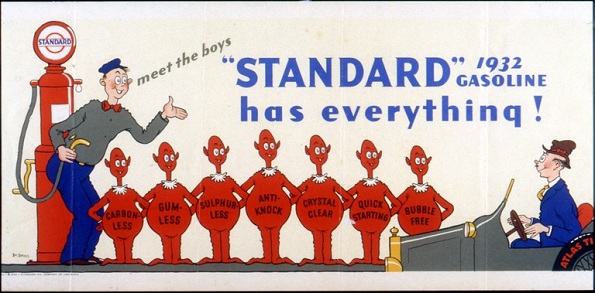
This 1932 Standard Oil Company (New Jersey) advertisement is among those preserved by the Dr. Seuss Collection of the Mandeville Special Collections Library at the University of California, San Diego.
At the University of California, San Diego, the Dr. Seuss Collection in the Mandeville Special Collections Library contains original drawings, sketches, proofs, notebooks, manuscript drafts, books, audio and videotapes, photographs, and memorabilia.

More than 8,500 items document and preserve Dr. Seuss’ creative achievements, beginning in 1919 with his high school activities and ending with his death in 1991.
Karbo-nockus and Other Critters
The future Dr. Seuss added a host of zoological oddities to Standard Oil’s lexicon while promoting the product of Esso (the phonetic pronunciation of the initials S and O first used in 1926). His critters promoted Essomarine oil and greases as well as Essolube Five-Star Motor Oil.
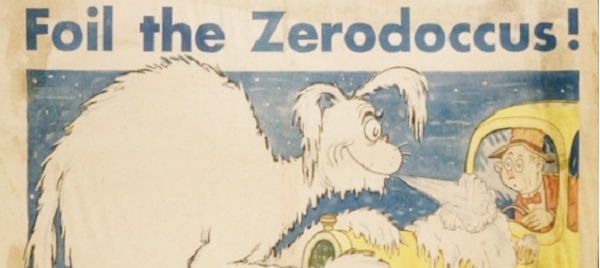
Standard Oil advertising campaigns provided a steady income to Geisel and his wife throughout his early days experimenting with his drawings.
Smiling, toothy creatures such as Zero-doccus, Karbo-nockus, Moto-raspus and Oilio-Gobelus appeared in advertisements that warned motorists of the hazards of driving without the protection of Standard Oil lubrication.
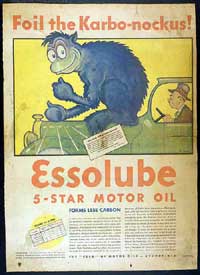
Motor oil cartoon ad drawn by the future children’s book author Dr. Seuss. First sold in the 1930s, Essolube has remained a popular product, today for ExxonMobil.
“Meet the Zero-doccus. He is the first if a group of terrible beasts that are being turned loose in the advertising of Essolube, Standard Oil Company (New Jersey) products,” reported the December 8, 1932, Printers’ Insider, an advertising trade journal.
Other Esso “moto-monsters” would be introduced in newspapers and outdoor posters in coming months, the trade journal proclaimed.
“These creatures symbolize and dramatize some of the troubles of motorists who use inferior oils. The Zero-doccus pounces on cold motors and makes quick starting difficult with ordinary oils,” the article noted. “He and his coming friends are the creations of Dr. Seuss of ‘Quick, Henry, the Flit’ fame.”
The Printers’ Insider article predicted the strange Esso creatures would prove popular when they appeared in ads nationwide.

A dependable income from Standard Oil during the Great Depression helped Dr. Seuss publish his first children’s book in 1936.
Seuss in Esso Navy
Throughout his early hard years, these Standard Oil advertising campaigns provided steady income to Geisel and his wife. “It wasn’t the greatest pay, but it covered my overhead so I could experiment with my drawings,” he later said.

Geisel noted his advertising work allowed him to experiment with creating subtle visual messages while using wacky rhymes in storytelling.
In 1936, Geisel designed Standard Oil’s Essomarine booth for the National Motorboat Show — and created the phenomenally successful “Seuss Navy.” Young and old visitors were commissioned as admirals and photographed with whimsical characters made of cardboard.

Standard Oil Company marketers promoted Essomarine products during the 1940 National Motor Boat Show in New York City.
By 1940, the Seuss Navy included more than 2,000 enthusiastic admirals (with such notables as bandleader Guy Lombardo). Geisel remembered that, “It was cheaper to give a party for a few thousand people, furnishing all the booze, than it was to advertise in full-page ads.”
As Dr. Seuss, Geisel wrote and illustrated his first children’s book, And to Think That I Saw It on Mulberry Street, published on December 21, 1937, by Vanguard Press after being rejected by 27 other publishers.
Twenty years later, The Cat in the Hat was inspired by a 1954 Life Magazine essay critical of children’s literacy and the stilted “See Spot Run” style of reading primers. Published in 1957, The Cat in the Hat used just 236 words — and only 14 of them with two syllables. It remains his most popular work.
The former Standard Oil advertising illustrator wrote more than 50 children’s books over a half-century career that brought the world Hop on Pop, Green Eggs and Ham and many others. Children lost a friend on September 24, 1991, when Theodor Seuss Geisel died at the age of 87.
View online the Dr. Seuss Collection: Advertising Artwork of Dr. Seuss, preserved by Mandeville Special Collections Library, University of California.
Kerosene in Art
At the beginning of the 20th century, French illustrator Jules Chéret (1836-1933) was famous for his lithograph posters for theatres, music halls, beverages, and medicines. During a long career, many of his commercial posters promoted a French petroleum company’s lamp oil.

Chéret, who would be called “the father of the modern lithograph” and “king of the poster,” produced popular posters for “Saxoleinem,” the company’s refined “pétole de sureté”– safety lamp oil.

French advertisement for “The Halo of the South,” a safety oil for lamps, in an 1895-1900 lithograph by artist Jules Chéret.
“He was often imitated, and an entire generation of artists would follow and build on his work. One of them was Henri de Toulouse-Lautrec,” notes Chicago’s Richard H. Driehaus Museum. “To acknowledge his debt to the older artist, Lautrec sent Chéret a copy of every poster he produced.”
Learn about more examples of artists and the petroleum industry in Oil in Art.
_______________________
Recommended Reading: Theodor Geisel: A Portrait of the Man Who Became Dr. Seuss (2010); The History of the Standard Oil Company: All Volumes
(2010); The History of the Standard Oil Company: All Volumes  (2015); Strategy and Structure: Chapters in the History of the American Industrial Enterprise (1962); Dr. Seuss & Mr. Geisel: A Biography (1995). Your Amazon purchase benefits the American Oil & Gas Historical Society. As an Amazon Associate, AOGHS earns a commission from qualifying purchases.
(2015); Strategy and Structure: Chapters in the History of the American Industrial Enterprise (1962); Dr. Seuss & Mr. Geisel: A Biography (1995). Your Amazon purchase benefits the American Oil & Gas Historical Society. As an Amazon Associate, AOGHS earns a commission from qualifying purchases.
_______________________
The American Oil & Gas Historical Society (AOGHS) preserves U.S. petroleum history. Please become an AOGHS annual supporter and help expand historical research. For more information, contact bawells@aoghs.org. Copyright © 2025 Bruce A. Wells.
Citation Information – Article Title: “Seuss I am, an Oilman.” Authors: B.A. Wells and K.L. Wells. Website Name: American Oil & Gas Historical Society. URL: https://aoghs.org/petroleum-art/seuss-the-oilman. Last Updated: January 9, 2025. Original Published Date: December 1, 2008.
by Bruce Wells | Jan 6, 2025 | This Week in Petroleum History
January 7, 1864 – Oilfield Discovery at Pithole Creek –
The once famous Pithole Creek oilfield was discovered in Pennsylvania with the United States Petroleum Company’s well reportedly located using a witch-hazel dowser. The discovery well, which initially produced 250 barrels of oil a day, brought a “black gold” rush as boom town Pithole made headlines five years after the first U.S. oil well drilled at nearby Titusville.
oilfield was discovered in Pennsylvania with the United States Petroleum Company’s well reportedly located using a witch-hazel dowser. The discovery well, which initially produced 250 barrels of oil a day, brought a “black gold” rush as boom town Pithole made headlines five years after the first U.S. oil well drilled at nearby Titusville.
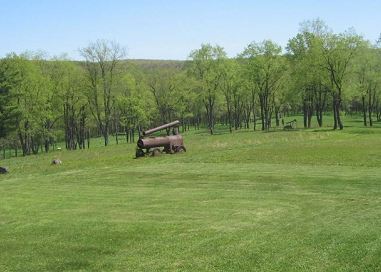
Boom town Pithole City’s history is preserved at Pennsylvania’s Oil Creek State Park. Photo by Bruce Wells.
Adding to the boom were Civil War veterans eager to invest in the new industry. Newspaper stories added to the oil fever — as did the Legend of “Coal Oil Johnny.” Tourists today visit Oil Creek State Park and its education center on the grassy expanse that was once Pithole.
January 7, 1905 – Humble Oilfield Discovery rivals Spindletop
C.E. Barrett discovered the Humble oilfield in Harris County, Texas, with his Beatty No. 2 well, which brought another Texas drilling boom four years after Spindletop launched the modern petroleum industry. Barrett’s well produced 8,500 barrels of oil per day from a depth of 1,012 feet.
The population of Humble jumped from 700 to 20,000 within months as production reached almost 16 million barrels of oil, the largest in Texas at the time. The field directly led to the 1911 founding of the Humble Oil Company by a group that included Ross Sterling, a future governor of Texas.
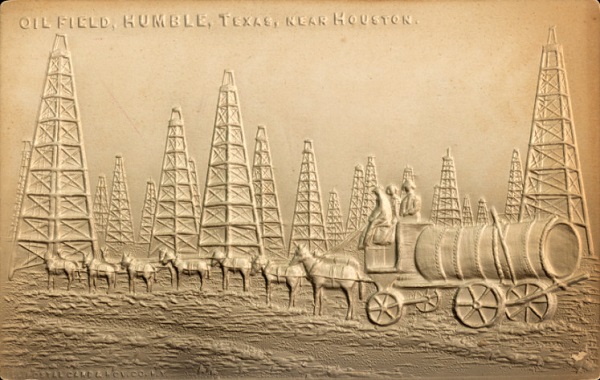
An embossed postcard circa 1905 from the Postal Card & Novelty Company, courtesy the University of Houston Digital Library.
“Production from several strata here exceeded the total for fabulous Spindletop by 1946,” notes a local historic marker. “Known as the greatest salt dome field, Humble still produces and the town for which it was named continues to thrive.” Another giant oilfield discovery in 1903 at nearby Sour Lake helped establish the Texaco Company.
Humble Oil, renamed Humble Oil and Refining Company in 1917, consolidated operations with Standard Oil of New Jersey two years later, eventually leading to ExxonMobil.

January 7, 1957 – Michigan Dairy Farmer finds Giant Oilfield
After two years of drilling, a wildcat well on Ferne Houseknecht’s Michigan dairy farm discovered the state’s largest oilfield. The 3,576-foot-deep well produced from the Black River formation of the Trenton zone.

After 20 months of on-again, off-again drilling, Ferne Houseknecht’s well revealed a giant oilfield in the southern Michigan basin.
The Houseknecht No. 1 discovery well at Rattlesnake Gulch revealed a producing region 29 miles long and more than one mile wide. It prompted a drilling boom that led to production of 150 million barrels of oil and 250 billion cubic feet of natural gas from the giant Albion-Scipio field in the southern Michigan basin.
“The story of the discovery well of Michigan’s only ‘giant’ oilfield, using the worldwide definition of having produced more than 100 million barrels of oil from a single contiguous reservoir, is the stuff of dreams,” noted Michigan historian Jack Westbrook in 2011.
in 2011.
Learn more in Michigan’s “Golden Gulch” of Oil.
January 7, 1913 – “Cracking” Patent improves Refining
William Burton of the Standard Oil Company’s Whiting, Indiana, refinery received a patent for a process that doubled the amount of gasoline produced from each barrel of oil refined. Burton’s invention came as gasoline demand was rapidly growing with the popularity of automobiles. His thermal cracking concept was an important refining advancement, although the process would be superseded by catalytic cracking in 1937.
January 8, 1903 – Sour Lake discovery leads to Texaco
Founded a year earlier in Beaumont, Texas, the Texas Company struck oil with its Fee No. 3 well, which flowed at 5,000 barrels a day, securing the company’s success in petroleum exploration, production, transportation and refining.

A monument marks the site where the Fee No. 3 well flowed at 5,000 barrels of oil a day in 1903, helping the Texas Company become Texaco.
“After gambling its future on the site’s drilling rights, the discovery during a heavy downpour near Sour Lake’s mineral springs, turned the company into a major oil producer overnight, validating the risk-taking insight of company co-founder J.S. Cullinan and the ability of driller Walter Sharp,” explained a Texaco historian. The Sour Lake field — and wells drilled in the Humble oilfield two years later — led to the Texas Company becoming Texaco (acquired by Chevron in 2001).
Learn more in Sour Lake produces Texaco.

January 10, 1870 – Rockefeller incorporates Standard Oil Company
John D. Rockefeller and five partners incorporated the Standard Oil Company in Cleveland, Ohio. The new oil and refining venture immediately focused on efficiency and growth. Instead of buying barrels, the company bought tracts of oak timber, hauled the dried timber to Cleveland on its own wagons, and built its own 42-gallon oil barrels.
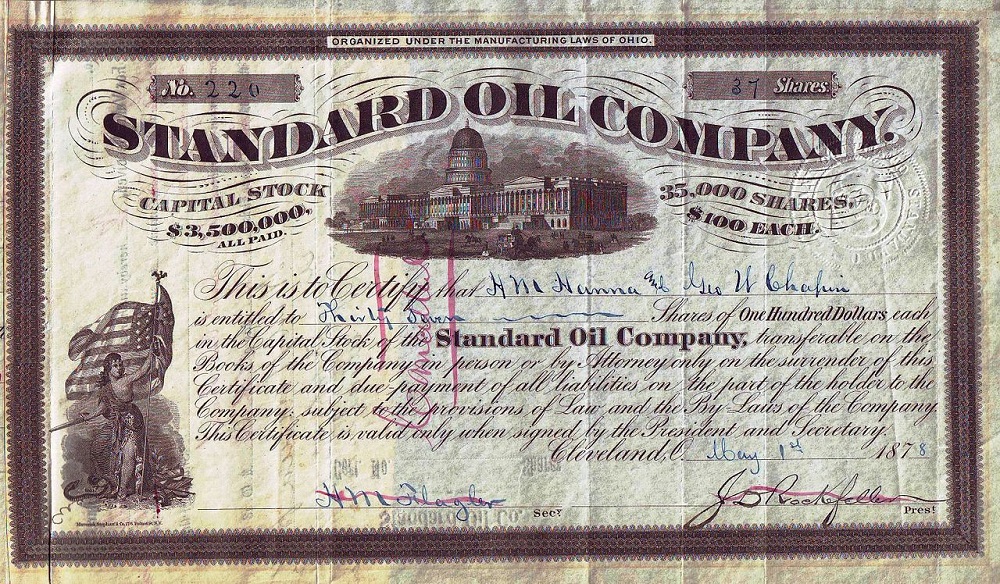
A stock certificate issued in 1878 for Standard Oil Company, which would become Standard Oil of Ohio (Sohio) following the 1911 breakup of John D. Rockefeller’s oil monopolies.
Standard Oil’s cost per wooden barrel dropped from $3 to less than $1.50 as the company improved refining methods to extract more kerosene per barrel of oil (there was no market for gasoline). By purchasing properties through subsidiaries, dominating railroads and using local price-cutting, Standard Oil captured 90 percent of America’s refining capacity.
January 10, 1901 – Spindletop launches Modern Petroleum Industry
The modern U.S. oil and natural gas industry began 123 years ago on a small hill in southeastern Texas when a wildcat well erupted near Beaumont. The Spindletop field, which yielded 3.59 million barrels of oil by the end of 1901, would produce more oil in one day than all the rest of the world’s oilfields combined.
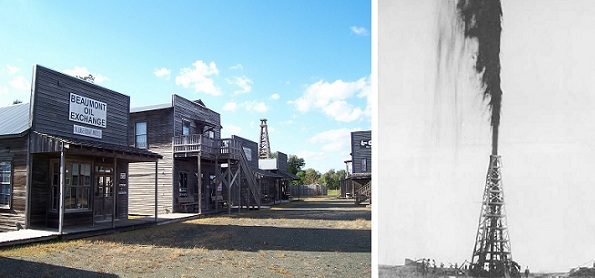
The Spindletop-Gladys City Boomtown Museum in Beaumont, Texas, opened in 1976 to educate visitors about the importance of the 1901 “Lucas Gusher.”
The “Lucas Gusher” and other nearby discoveries changed American transportation by providing abundant oil for cheap gasoline. The drilling boom would bring hope to a region devastated just a few months earlier by the Galveston Hurricane, still the deadliest in U.S. history. Petroleum production from the well’s geologic salt dome had been predicted by Patillo Higgins, a self-taught geologist and Sunday school teacher.
Learn more in Spindletop launches Modern Petroleum Industry.
January 10, 1919 – Elk Hills Oilfield discovered in California
Standard Oil of California discovered the Elk Hills field in Kern County, and the San Joaquin Valley soon ranked among the most productive oilfields in the country. It became embroiled in the 1920s Teapot Dome lease scandals and yielded its billionth barrel of oil in 1992. Visit the petroleum exhibits of the Kern County Museum in Bakersfield and at the West Kern Oil Museum in Taft.

January 10, 1921 – Oil Boom arrives in Arkansas
“Suddenly, with a deafening roar, a thick black column of gas and oil and water shot out of the well,” noted one observer in 1921 when the Busey-Armstrong No. 1 well struck oil near El Dorado, Arkansas. H.L. Hunt would soon arrive from Texas (with $50 he had borrowed) and join lease traders and speculators at the Garrett Hotel — where fortunes were soon made and lost. “Union County’s dream of oil had come true,” reported the local paper. The giant Arkansas field would lead U.S. oil output in 1925 with production reaching 70 million barrels.
Learn more in First Arkansas Oil Wells.
January 11, 1926 – “Ace” Borger discovers Oil in North Texas
Thousands rushed to the Texas Panhandle seeking oil riches after the Dixon Creek Oil and Refining Company completed its Smith No. 1 well, which flowed at 10,000 barrels a day in southern Hutchinson County. A.P. “Ace” Borger of Tulsa, Oklahoma, had leased a 240-acre tract. By September, the Borger oilfield was producing more than 165,000 barrels of oil a day.

A downtown museum exhibits Borger’s oil heritage. Photo by Bruce Wells.
After establishing his Borger Townsite Company, Borger laid out streets and sold lots for the town, which grew to 15,000 residents in 90 days. When the oilfield produced large amounts of natural gas, the town named its minor league baseball team the Borger Gassers. The team left the league in 1955 (owners blamed air-conditioning and television for reducing attendance).
Dedicated in 1977, the Hutchinson County Boom Town Museum in Borger celebrates “Oil Boom Heritage” every March.
January 12, 1904 – Henry Ford sets Speed Record
Seeking to prove his cars were built better than most, Henry Ford set a world land speed record on a frozen Michigan lake. At the time his Ford Motor Company was struggling to get financial backing for its first car, the Model T. It was just four years after America’s first auto auto show.
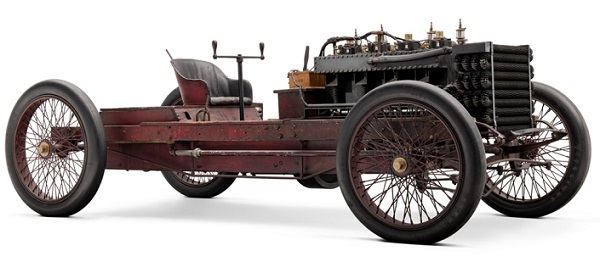
The Ford No. 999 used an 18.8 liter inline four-cylinder engine to produce up to 100 hp. Image courtesy Henry Ford Museum.
Ford drove his No. 999 Ford Arrow across Lake St. Clair, which separates Michigan and Ontario, Canada, at a top speed of 91.37 mph. The frozen lake “played an important role in automobile testing in the early part of the century,” explained Mark DIll in “Racing on Lake St. Clair” in 2009. “Roads were atrocious and there were no speedways.”
Learn about a 1973 natural gas-powered world land speed record in Blue Flame Natural Gas Rocket Car.

January 12, 1926 – Texans patent Ram-Type Blowout Preventer
Seeking to end dangerous and wasteful oil gushers, James Abercrombie and Harry Cameron patented a hydraulic ram-type blowout preventer (BOP). About four years earlier, Abercrombie had sketched out the design on the sawdust floor of Cameron’s machine shop in Humble, Texas. Petroleum companies embraced the new technology, which would be improved in the 1930s.
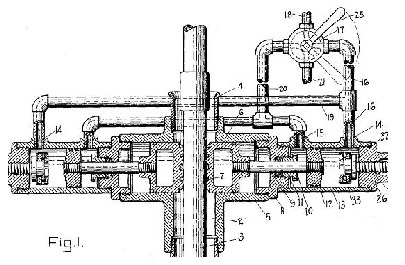
James Abercrombie’s design used hydrostatic pistons to close on the drill stem. His improved blowout preventer set a new standard for safe drilling
First used during the Oklahoma City oilfield boom, the BOP helped control production of the highly pressurized Wilcox sandstone (see World-Famous “Wild Mary Sudik”). The American Society of Mechanical Engineers recognized the Cameron Ram-Type Blowout Preventer as an “Historic Mechanical Engineering Landmark” in 2003.
Learn more in Ending Oil Gushers – BOP.
_______________________
Recommended Reading: Myth, Legend, Reality: Edwin Laurentine Drake and the Early Oil Industry (2009); Humble, Images of America (2013); Michigan Natural Resources Trust Fund 1976-2011: A 35-year Michigan Oil and Gas Industry Investment Heritage in Michigan’s Public Recreation Future
(2013); Michigan Natural Resources Trust Fund 1976-2011: A 35-year Michigan Oil and Gas Industry Investment Heritage in Michigan’s Public Recreation Future (2011); Handbook of Petroleum Refining Processes
(2011); Handbook of Petroleum Refining Processes (2016); Black Gold in California: The Story of California Petroleum Industry (2016); Titan: The Life of John D. Rockefeller, Sr.
(2016); Black Gold in California: The Story of California Petroleum Industry (2016); Titan: The Life of John D. Rockefeller, Sr. (2004); Giant Under the Hill: A History of the Spindletop Oil Discovery at Beaumont, Texas, in 1901
(2004); Giant Under the Hill: A History of the Spindletop Oil Discovery at Beaumont, Texas, in 1901 (2008); Early Louisiana and Arkansas Oil: A Photographic History, 1901-1946
(2008); Early Louisiana and Arkansas Oil: A Photographic History, 1901-1946 (1982); I Invented the Modern Age: The Rise of Henry Ford
(1982); I Invented the Modern Age: The Rise of Henry Ford (2014); Drilling Technology in Nontechnical Language
(2014); Drilling Technology in Nontechnical Language (2012). Your Amazon purchase benefits the American Oil & Gas Historical Society. As an Amazon Associate, AOGHS earns a commission from qualifying purchases.
(2012). Your Amazon purchase benefits the American Oil & Gas Historical Society. As an Amazon Associate, AOGHS earns a commission from qualifying purchases.
_______________________
The American Oil & Gas Historical Society (AOGHS) preserves U.S. petroleum history. Please become an AOGHS annual supporter and help maintain this energy education website and expand historical research. For more information, contact bawells@aoghs.org. Copyright © 2025 Bruce A. Wells. All rights reserved.






















